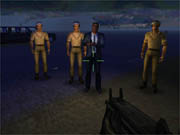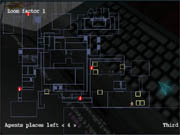Secret Service, Activision's new value-priced tactical shooter, has this one really cool effect: Instead of going through canned death animations, characters react realistically according to the physical properties of their surroundings. For instance, shoot a guy who's standing right in front of a building, and he may fall backward, hit the wall, slide down it, and then slump forward--all apparently in real time. It's a great effect, and it's a wonder more games don't use something like it. Unfortunately, it only works about half the time. As often as not, guys will fall with their head through a wall or their whole body magically lodged halfway through a staircase. Alternately, the body may land correctly but never completely settle and just lie there undulating forever. This half-great, half-broken effect epitomizes Secret Service--a lot of potential hampered by sloppy execution.

Secret Service is subtitled "In Harm's Way." Just to prove the title isn't kidding, the game includes the most difficult first level ever. Instead of offering you some training or making an attempt to ease you into things, level one starts you right in the middle of an intense firefight. You can hear gunshots and people screaming, but, luckily, you're standing in a windowless room inside a building. That lucky feeling lasts about a half a second, though, because, more or less immediately, bullets start tearing through the room's walls. Again, this is all part of the game's admirable physics engine. Bullets realistically penetrate things like furniture, windows, drywall, and other things made of flimsy materials. In fact, you can blow most doors right off their hinges, which is especially satisfying.
Your first inclination may be to watch the light streaming through the bullet holes in the wall and think, "Hey, that's pretty neat." If so, your second inclination will be to hit the retry button, because--seeing as Secret Service is a tactical shooter--a couple of hits will kill you. And not only do you have to get yourself to some safe cover almost instantly, but the US national security advisor is also standing right next to you, and it's your job to keep him alive. Using a series of hotkeys, you can issue commands to him such as "follow me," "wait here," and "get down."
Once you and the security advisor manage to sprint to safety, more problems arise when it becomes evident that your goal for the mission isn't entirely obvious. The mission briefing clearly states that your protectee's code name is "Kingsize." Twenty seconds into the level, a radio transmission tells you to get "Mud Mover" "across the street." Who's "Mud Mover"? This may be a spoiler, but it's actually a double-secret code name for "Kingsize"--a state secret that you evidently don't have security clearance for, since nobody ever mentions it.
"Across the street" is also kind of vague. Secret Service's graphics engine, while not exactly state of the art in terms of architectural details, lighting, and quality of textures, can render some impressively complex cityscapes. The first mission takes place in a large cluttered section of a Middle Eastern urban area. Most of the buildings can be entered, and you can get out on balconies and rooftops in order to get the drop on the level's throngs of terrorists. However, the tangle of streets and alleys makes it sort of unclear where the heck you're supposed to actually take the mysterious Mud Mover.
Assuming you make it through the first level, the following 15 offer the same mix of excitement, confusion, and frustration in various proportions. In level two, you don't have to protect anyone, but you must navigate a terrorist-infested maze of streets to reach a safe house. The complicated mission-briefing map is intimidating, but it at least marks your destination with a big green square. Unfortunately, the in-game map doesn't note this destination area or any other points of interest necessary for completing a given mission. The second level is almost as difficult as the first, and it's also longer, which is a problem, given the fact that Secret Service doesn't permit you to save during a mission.
Later levels are insanely hard, moderately tough, or incredibly easy, but not in any particular pattern. In fact, as if to reject the classic design principle of escalating difficulty altogether, the final level is as ridiculously simple as the first level is ridiculously hard.
Some missions put a few fellow agents under your command. The interface for controlling them is well developed--there are about 10 different orders you can give them. Unfortunately, for the most part, your teammates are more inept than useful. They'll often stand there and stare into space while a couple of terrorists five feet away take turns blasting you with shotguns. In what might be a tacit acknowledgement of these AI deficiencies, only four of the 16 missions include teammates.
The enemy AI isn't great, but it's serviceable. Sometimes terrorists will duck behind cover, and sometimes they'll just stand there. However, the damage modeling is realistic enough that each enemy is potentially deadly. Thankfully, in direct opposition to a design flaw common to the genre, the enemies aren't all inhumanly good shots. Often, their shots will whiz by you and impact something in the surrounding environment. This small detail makes the firefights significantly more exciting than in games where every opponent is a deadeye sniper.

Four multiplayer modes are included: deathmatch, team deathmatch, capture the flag, and survivor. Between its 24 multiplayer levels, its cool physics engine, and its 16 realistically modeled weapons, Secret Service potentially offers some decent competition to tactical shooters such as Ghost Recon and Counter-Strike. Here again, though, Secret Service undercuts its strengths by not including a key component--there's no in-game server browser or support for a third-party player-matching service, such as GameSpy. So, regardless of how good Secret Service's multiplayer mode may be, actually finding a game is unduly difficult. This difficulty, combined with no bot support, means you may never even get a chance to try the multiplayer game.
At moments, Secret Service is thrilling in spite of itself. A few of the levels offer a great blend of architecture, enemy placement, and barely survivable mayhem. One level, which has you rescuing a protected witness from a besieged motel, is an incredible gauntlet of shotgun blasts and exploding panes of glass. It's worth five bucks all by itself. As with all value-priced titles, you have to take the good with the bad. However, since it retails for $30, Secret Service doesn't even manage to be a full-fledged budget title. The game just can't catch a break.